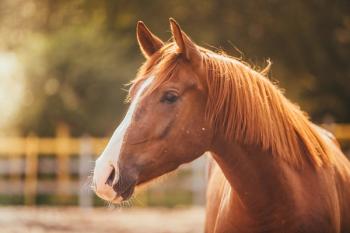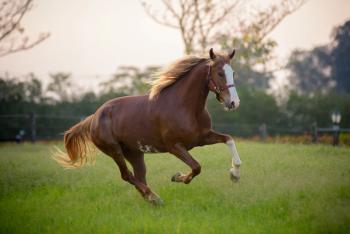
Diagnosis and treatment of myofascial pain in the equine patient (Proceedings)
There are a number of special considerations that must be addressed when treating equine patients with myofascial pain and dysfunction.
There are a number of special considerations that must be addressed when treating equine patients with myofascial pain and dysfunction. Management, training and behavioral issues may affect both the prevalence of myofascial pain and its response to treatment. These issues affect the physical and mental health of the horse, alter the horse's susceptibility to injury and ability to heal, and influence athletic performance.
- Stabling practices: Horses confined to a stall or small paddock may have limited access to turnout. Movement deprivation results in loss of flexibility, strength and neuromotor function and increased susceptibility to injury. Lack of access to grazing with the head lowered prevents repetitive stretching of the topline that maintains flexibility of epaxial structures. Absence of stresses to joints and connective tissues weakens cartilaginous and ligamentous structures. Failure to provide adequate warm up prior to activity also increases susceptibility to injury.
- Isolation: Isolation and lack of herd interactions result in boredom, development of stable vices and behavioral and training difficulties. Isolated horses also experience stress and anxiety that promotes excessive muscle tension, especially in the jaw, poll and epaxial muscles.
- Training anxiety: Aggressive training methods lead to anxiety and a "flight" response in the horse. The horse in an alerted, anxious state will experience an increase in heart rate, secrete cortisol, raise its head and tense the muscles to prepare for flight. Elevated head and chronic tension in the neck and back provoke myofascial pain and dysfunction of the poll and epaxial muscles.
- Tack and rider issues: Ill-fitting saddles, heavy riders and unskilled riders are painful to the horse's back. The traumatized epaxial muscles contract in response to the painful stimuli. Fascial restrictions and multiple trigger points will form. The inability of the epaxial muscles to function properly will ultimately affect the performance of the horse.
Diagnosis of myofascial pain
The examination of the horse with a suspected myofascial pain disorder varies from that of the small animal because of the very large muscle mass, much of which is inaccessible. In addition the aforementioned management, training and behavioral issues play a significant role in the assessment and treatment of the equine patient.
The examination of the horse proceeds sequentially through the following steps
- History: Common signs exhibited by the horse experiencing myofascial pain include: sourness, head tossing, tail swishing, bucking, bolting, failure to bend or yield, stumbling, tripping, short striding, obscure lameness, won't collect, difficulties with canter or lead changes and decrease in performance.1
- Pain assessment: Subjective pain can be quickly assessed with a needle cap run longitudinally over the large muscle groups, noting where the horse reacts in a manner indicating pain. Pressure algometry, employing a compressive-force gauge provides a means of objectively quantifying pain in the horse. Areas demonstrating a painful response are assessed more thoroughly through manual palpation. Altered tissue texture, loss of resiliency and "hard" muscles are common signs of myofascial dysfunction.
- Posture evaluation: A static postural examination is performed, observing the horse from the lateral, cranial, caudal, and dorsal views. The horse should be assessed for muscle mass and symmetry, flat-appearing muscles, height and symmetry of bony landmarks, symmetry of weight bearing or lean, and spinal curves. Of particular importance in the horse is the relative degree of lordosis, or extension of the cervical and thoracolumbar spine. Horses that tend to adopt a lordotic posture with elevated head and inverted neck will often have myofascial abnormalities of the poll and epaxial muscles.
- Motion examination: A motion examination is performed to assess the mobility and flexibility of the joints and myofascial tissues. Passive range of motion of the shoulder and hip assesses the flexibility of the large, proximal limb musculature. Baited stretches of the cervical spine reveal the flexibility of the cervical and poll muscles. Passive motioning of the thoracolumbar spine and pelvis assess joint mobility, muscle tension and ligamentous flexibility of paraspinal tissues.
- Gait evaluation: Gait should be evaluated for not only for lameness, but also quality and symmetry of limb movements and degree of spinal movements. Stiffness of the spine during locomotion is correlated with back pain and lameness issues.
- Ability to collect: Collection is attained by the selective contraction and relaxation of specific muscle groups resulting in a change in the shape of the spine. This enables the horse to support his back and carry the rider while maintaining lightness, self-carriage and responsiveness to the aids. Horses experiencing back pain and tension will have difficulty with collection and altered performance. The primary actions that allow this change in posture are:
o Relaxation of the longissimus dorsi. This ensures that the longissimus dorsi is free to contract and relax as needed to allow and control lateral and dorsal–ventral movements of the spine in sequence with the gait cycle.
o Contraction of the iliopsoas, flexion of the lumbosacral joint (as well as abdominal muscle contraction, which flexes the spine).
o Contraction of the scalenus and longus colli, which flexes the lower cervical spine and raises the base of the neck (telescoping maneuver).
o Relaxation of the dorsal poll muscles and contraction of the ventral neck muscles, allowing flexion of the poll.
o The creation of passive tension in the nuchal ligament and supraspinous ligament, which raises the back, provided the longissimus dorsi is not in a state of contraction.
Treatment of myofascial pain
Myofascial release
Slow, sustained pressure into the barrier of tissue restriction will elongate myofascial tissues. Commonly affected muscles that respond well to myofascial release include masseter, small muscles of the poll, brachiocephalicus, pectorals, serratus, trapezius, latissimus dorsi, longissimus, iliocostalis, iliacus, quadriceps, gluteals and hamstrings.
Spinal segmental mobilization
Ligamentous restriction of thoracolumbar facets and spinal ligaments will alter spinal segmental mobility and proper function of the back in the riding horse. Segmental mobilization will improve flexibility, decrease muscle tension and restore segmental motion.
Stretching
Both active and passive stretches applied to the spine and limbs will reduce myofascial pain and restrictions and enable the horse to maintain flexibility in the face of repetitive activities that tend to exacerbate myofascial dysfunctions.
Dry needling of trigger points
Dry needling of trigger points can be very advantageous in the equine where it is difficult to utilize manual pressure due to the depth of the tissues. Longer needles are able to penetrate and deactivate trigger points that are otherwise difficult to treat.
Therapeutic exercises for strengthening of core muscles
A pictorial of therapeutic exercises will be presented which illustrates a core-strengthening program for the riding horse.
In conclusion, myofascial pain can be successfully treated in the equine if the complexities of horse, rider and management interactions are addressed within the treatment protocol.
References
1. Macgregor J, Graf von Schweinitz D. Needle electromyographic activity of myofascial trigger points and control sites in equine cleidobrachialis muscle – an observational study. Acup in Med 2006; 24(2):61-70.
Newsletter
From exam room tips to practice management insights, get trusted veterinary news delivered straight to your inbox—subscribe to dvm360.






